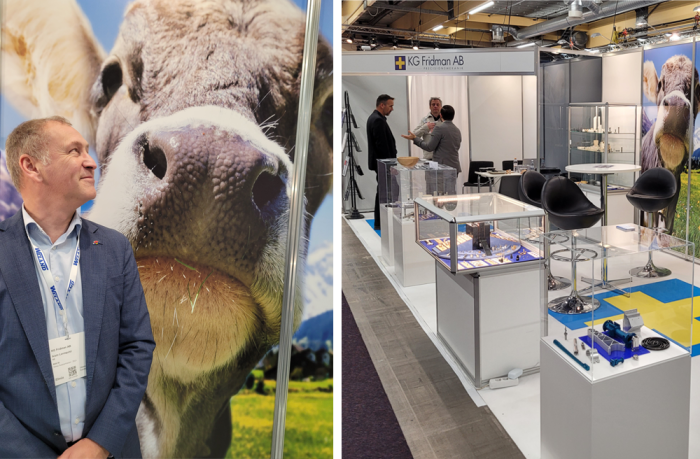
Tell us about KG Fridman, how did it all start?
1927: The company was founded by KG Fridman and sells mechanical components to Victor Hasselblad, who had just started his camera production. Hasselblad remains a customer for 75 consecutive years!
The 1930s: KG Fridman sells fine blanked components to, among others, Halda and Facit.
The 1940s: The truck manufacturer Scania is among the customers.
The 1950s: KG Fridman sells Swiss precision ball bearings to ABU Svängsta, for their new Ambassadeur fishing reel. Rumour has it that after each new annual contract was signed, KG bought himself a new car.
The 1960s: The moon landing is documented with Hasselblad cameras and KG Fridman AB’s components on board.
The 1970s: KG Fridman AB starts selling components sleeves to Rb70 (Bofors).
The 1980s: KG Fridman begins to stock Magnesium Tooling Plates (-82), verbal agreement with DOW for European rights to sell Mg. Our Mg customers are primarily in Germany, Austria, Italy, Switzerland and Sweden.
The 1990s: KG Fridman introduces solid precious metal alloys to Danish hearing aid manufacturers, replacing gold-plated CuBe in components, significantly improving the quality of the final product! (Note: Danish companies had 60% of the world market for hearing aids).
The 2000s: KG Fridman is successful selling advanced machined components, including gears and planetary gearboxes with high requirements!
The 2010s: KG Fridman starts selling technical ceramics and ceramic/metal composites including components thereof!
The 2020s: KG Fridman continues to focus on offering various mechanical components and materials to Nordic customers with high demands and takes aim at the centenary in 2027!
What type of products do you sell, and which markets do you target?
We focus on mechanical components manufactured to customer drawings. Our suppliers of mechanical components are located in Western Europe and offer high quality, examples are; gear manufacturing, milling, turning, CNC machining, miniature and high-speed ball bearings, ball screws, screws, and bolts in high-strength materials (certified EN9100 for the aerospace industry), assembly of fine mechanics on demand (medical certification to EN13485), ceramic components to, among other the automotive industry. Everything from single details to medium-sized series of perhaps 10,000 parts. Some of our suppliers are currently supply the Swiss watch industry, while others supply materials and components to CERN in Geneva. In the Nordic region, our customers are mostly found within Medtech, metrology, the defence industry, aircraft & aerospace sectors etc. – simply customers with high requirements and expectations. We have therefore also chosen to be members of the organisation Big Science Sweden!
We strive to find and offer solutions to customers’ problems; we want our company name to be associated with components of high and consistent quality. We often offer materials or components that are not so easy to source.
What do you think is the most important thing to stand out in your industry today? And how have you adapted to it?
As some of our strengths can be mentioned that we try to be responsive and understand what problem the customer wants to find a solution to and then communicate that to our suppliers, companies that are all specialised in their respective fields. We can also find and propose collaborations between two or more of our manufacturing companies to offer a more complete solution.
We rely on language skills, technical understanding, a wide range of niche suppliers, and a personal commitment as well as a very high degree of transparency. Many agencies, as it was commonly called in the past, were often seen with some skepticism – while our customers (our suppliers’ customers) are offered a direct contact with the suppliers to a very high degree, something that is almost a requirement in several of the industries where we are active. We guarantee that we can help customers with simplifications and improvements, suggestions for new materials, and so on.
We also often accompany our customers when they want to visit the manufacturers and vice versa, i.e., we visit the customers together with representatives of the suppliers. We represent companies that usually have between 15 – 50 employees and we prefer to call ourselves their sales organisation in the Nordics.
If you were to look into the future, what do you think the development looks like going forward for your industry?
What is present today was the “future” perhaps 10 years ago and if we want to remain and survive as a company, it is important for us to continue to be relevant to our market and our customers, just like everyone else of course. We, therefore, need to stay at the forefront of technological development and to an as great extent as possible, try to understand what will be in demand in the future. Fortunately, we have the help of our niche suppliers because they know their technical areas. We also supplement our supplier flora from time to time because some product categories may be phased out over time.
It is important for us to enter the customers’ development projects as early as possible so that we and our suppliers are allowed to inform about limitations and opportunities, thereby the development work can go faster. We then also gain knowledge about which challenges our customers are looking for solutions to and what they want to achieve.
Marketing is also a constant challenge for small businesses with limited budgets. We continue to invest in visiting, but also exhibiting at various fairs. Next up is Elmia Subcontractor in Jönköping in November. We will have six co-exhibitors with us in our largest booth (B08:30) to date and hope to meet many existing and new customer contacts during the fair.
Here you find KG Fridman
Website: www.fridman.com